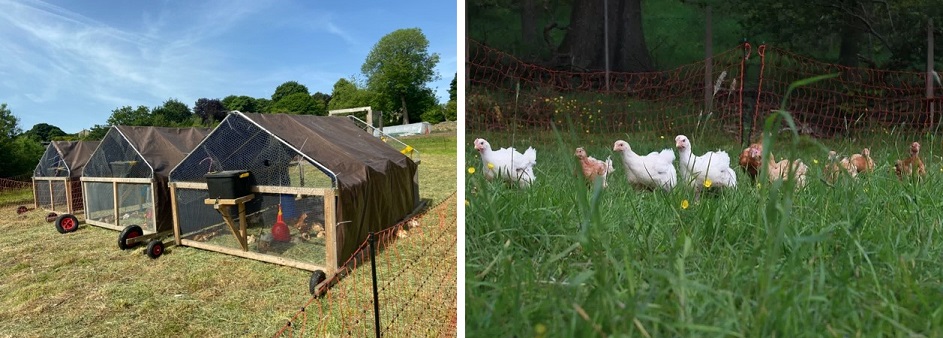Dr John Lever
Director, Centre for Sustainability, Responsibility, Governance and Ethics
Reader at Department of Management, Huddersfield Business School
I recently visited a new micro poultry farm nestled into the gentle slopes of the beautiful Holme Valley on the outskirts of Huddersfield in West Yorkshire. After seven years working on intensive farms, the owner Rebecca has decided it is time to farm differently. She is motivated to produce high quality food for local people using ethical, sustainable methods, and the farm adheres to strict regenerative principles and practices.
Raised in small groups with low stocking densities, each chicken at Yorkshire Pasture Poultry has access to fresh air and sunlight every day. As we start talking, Rebecca explains how she moves the electric fence that surrounds the three mobile coops (2 with broilers, 1 with layers) daily to give her chickens access to recently cleared patches of rough grass and brambles, and how natural fertilization regenerates each new space into lush green pasture.
When they arrive as day old chicks, each bird is placed in a brooder in a poly tunnel with fresh bedding. Depending on the weather and time of year, they stay here for up to 3 weeks until they are ready for pasture life. After two vaccines for common chicken diseases just after hatching, the birds do not receive any unnecessary medicines or antibiotics. Certified by A Greener World, Rebecca uses slow growing breeds, which are encouraged to be active and forage in a natural environment unhindered by fertilisers or chemicals.
As we step over the fence into today’s space (one of the hottest days of the year so far), the chickens remain calm and unmoved, quietly resting in the shade after their early morning pecking and foraging. Unlike soya fed industrial chicken (which is linked to deforestation), Rebecca’s birds are fed a soya free diet containing grains grown in the UK.
Yorkshire Pasture Poultry currently operates from May to October and it takes just two days for fresh chicken to reach customers. Rebecca currently sells at regional farmers markets. She also freezes some products for sale throughout the winter months and is now offering farm shares to connect with local people who are inclined to support independent community-based farms. Only one chicken has escaped so far to be eaten by a fox. Other challenges remain, not only explaining the benefits to passing walkers, but keeping the expectations of potential stockists under control.
This goes to the heart of the issues facing many of the new regenerative food enterprises that are springing up around the country. Do they compromise their key ethical and sustainability principles by using traditional logistics (that send products to a depot miles away for distribution back to local people) or do they sell direct to the community via farmers markets and direct sales channels? Do they scale up? Or do they scale out and help like-minded people to replicate their practices and develop similar regenerative enterprises?
Although they are enacted in multiple ways, all such enterprises are inspired by nature; each is concerned with what living systems can teach us. A good way of thinking about the issues involved is to consider what have been referred to as nested markets, which ‘are often related to, if not grounded upon, local and regional resources’. This is the future of food systems. How we get there is still in the making through the social struggles and market creations of Rebecca and other like-minded people.

